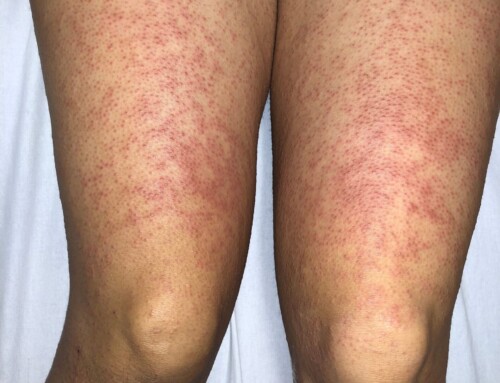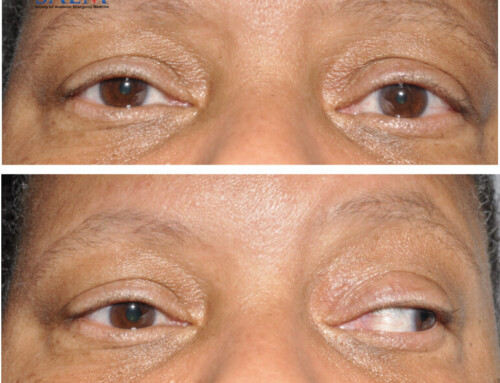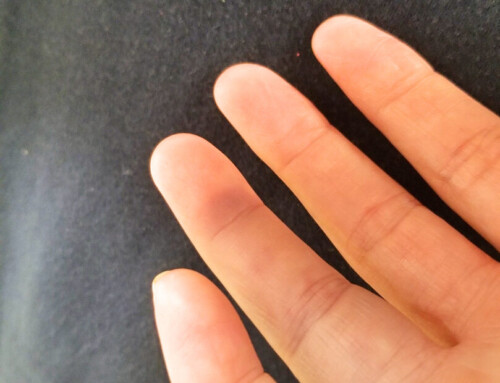
A 50-year-old Caucasian female with a history of hypertension, coronary artery disease, and insulin-dependent diabetes mellitus presents to the emergency department with a complaint of painful sores on the top of her left foot. She notes that ulcerations have formed over the past two weeks and reports a history of multiple recurrent usually non-tender skin lesions to her lower extremities, forearms, and hands over the past twenty years. She is homeless and medically non-compliant secondary to financial issues.
Vitals: T 37.2°C; BP 149/77; HR 94; RR 20
Skin: Multiple yellow-brown and violaceous plaques on the pretibial lower extremities and feet, some exhibiting ulceration with central necrosis and surrounding erythema. Raised reddish-brown well-demarcated plaques with waxy centers were also noted on the dorsal forearms and hands.
Glucose: 539 (with a normal anion gap)
Hemoglobin A1C: 10.9
Necrobiosis Lipoidica – This patient had a previous skin biopsy with histopathologic changes demonstrating a granulomatous dermatitis involving the dermis and subcutaneous tissues with necrobiosis of collagen and inflammatory infiltrates of lymphocytes and plasma cells consistent with a diagnosis of necrobiosis lipoidica.
Necrobiosis lipoidica is a rare, chronic, idiopathic, granulomatous disease of collagen degeneration classically associated with type 1 diabetes (with a prevalence of 0.3 to 1.2%). It may present as the first clinical finding of or a precursor to diabetes, although its course is unaffected by glycemic control and it is unrelated to other diabetic complications including renal, ocular, and vascular problems. It has been associated with thyroid disease, inflammatory bowel disease, rheumatoid arthritis, and sarcoidosis. It may be equally common in patients without diabetes, hence was renamed without the term “diabeticorum”.
Necrobiosis lipoidica typically is asymptomatic and presents in females (average onset at age of 30) as small, well-demarcated papules that expand into waxy-centered plaques with indurated borders that may resolve spontaneously (up to 17%) or may be complicated by ulceration, infection, and occasionally transformation to squamous cell carcinoma. The differential diagnosis includes other granulomatous and inflammatory diseases such as granuloma annulare, sarcoidosis, rheumatoid arthritis, and necrobiotic xanthogranuloma. The diagnosis is suggested by clinical presentation and is proven by biopsy.
Complications of necrobiosis lipoidica include long-term scarring, ulceration (more common in males), infection, and when lesions are chronic they may rarely transform into squamous cell carcinoma. There is no cure for necrobiosis lipoidica, and some skin lesions may resolve spontaneously, therefore, treatment is focused on addressing any complications. Multiple medical and surgical interventions have been tried. Topical and intra-lesional corticosteroids have been used to stabilize rapidly enlarging lesions with limited success, however, have the potential to cause further skin atrophy. Surgical interventions including debridement and skin grafting are discouraged as in necrobiosis lipoidica trauma tends to induce the Koebner phenomenon.
Take-Home Points
- Necrobiosis lipoidica is an idiopathic rare skin disease classically associated with insulin-dependent diabetes mellitus but may affect otherwise healthy individuals.
- More common in females but more severe in males, necrobiosis lipoidica usually affects the pretibial lower extremities, may present in various stages, and has no known cure.
- Non-diabetic patients presenting with necrobiosis lipoidica should be monitored for the development of diabetes mellitus, thyroid and inflammatory diseases, and squamous cell carcinoma.
- Lepe K, Riley CA, Salazar FJ. Necrobiosis Lipoidica. [Updated 2022 Dec 1]. In: StatPearls [Internet]. Treasure Island (FL): StatPearls Publishing; 2022 Jan-. Available from: https://www.ncbi.nlm.nih.gov/books/NBK459318/ PMID:29083569.
- Kota SK, Jammula S, Kota SK, Meher LK, Modi KD. Necrobiosis lipoidica diabeticorum: A case-based review of literature. Indian J Endocrinol Metab. 2012 Jul;16(4):614-20. doi: 10.4103/2230-8210.98023. PMID: 22837927; PMCID: PMC3401767.
Copyright
Images and cases from the Society of Academic Emergency Medicine (SAEM) Clinical Images Exhibit at the 2023 SAEM Annual Meeting | Copyrighted by SAEM 2023 – all rights reserved. View other cases from this Clinical Image Series on ALiEM.

Samuel Sternberg
Auburn University College of Science and Mathematics

Latest posts by Samuel Sternberg (see all)
- SAEM Clinical Images Series: A Case of Painful Skin Lesions - October 20, 2023

Michael Sternberg, MD
Department of Emergency Medicine
University of South Alabama

Latest posts by Michael Sternberg, MD (see all)
- SAEM Clinical Images Series: Enigmatic Traumatic Hip Pain - December 22, 2023
- SAEM Clinical Images Series: Intracranial Abnormality - October 27, 2023
- SAEM Clinical Images Series: A Case of Painful Skin Lesions - October 20, 2023




